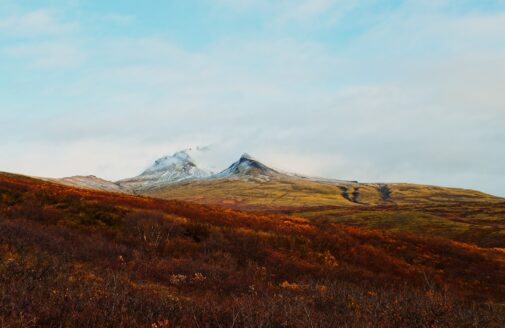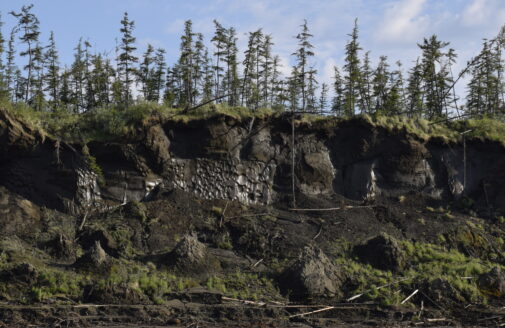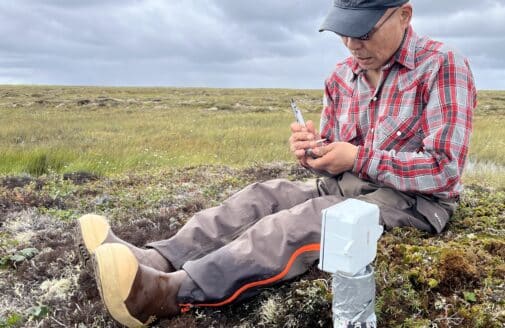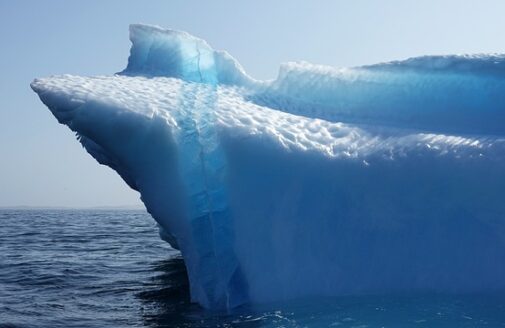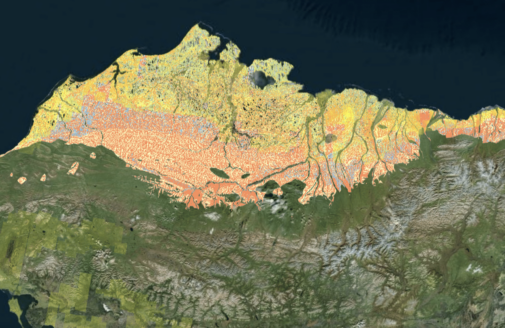What can be done about permafrost thaw?
Monitor, model, and make sure Arctic communities have the support they need
Woodwell President and CEO, Max Holmes, collects equipment used for Arctic research.
photo by John Le Coq
With the Arctic warming 3 to 4 times faster than the rest of the world, permafrost thaw has become a significant climate threat. Scientists estimate that permafrost contains 1.4 trillion tonnes of carbon, an amount more than double what is currently in the Earth’s atmosphere. That carbon sink is stable as long as it stays frozen, but with recent and projected thaw, the organic matter in permafrost is breaking down and releasing carbon dioxide and methane into the atmosphere, increasing the rate of climate change.
What we’re doing
Addressing this issue requires extensive data collection on permafrost emissions, as well as equitable strategies for adaptation by Arctic communities. To tackle this issue, Woodwell has partnered with the Arctic Initiative at Harvard Kennedy School, the Alaska Institute for Justice, and the Alaska Native Science Commission to connect experts in climate science, human rights, and public policy with frontline communities and high-level decision makers. The partnership is pioneering a six-year research program called Permafrost Pathways that will develop action plans to address the compounding impacts of permafrost thaw.
Permafrost thaw is an issue that affects everyone.
With the understanding that this needs to be a sustainable process with long-term impact, Permafrost Pathways’ scientists are expanding and coordinating a pan-Arctic carbon monitoring network to improve the accuracy of permafrost thaw emissions estimates. More precise measurements will fill critical data gaps and reduce uncertainties, so that permafrost emissions can be factored into global carbon budgets, climate models, targets, and measures for mitigation and adaptation. That, combined with high-resolution satellite and aircraft-based observations and advanced computer modeling, will allow for tracking the changing landscape in near real-time and more accurately projecting future emissions.
Permafrost Pathways is also collaborating with local communities to co-create Indigenous-led adaptation strategies. For many, relocation or infrastructure upgrades are needed urgently, but there is currently no process or resources to enable communities to move forward. With Arctic residents already feeling the brunt of climate change, the involvement of frontline communities is crucial in developing successful adaptation plans and effective policies.
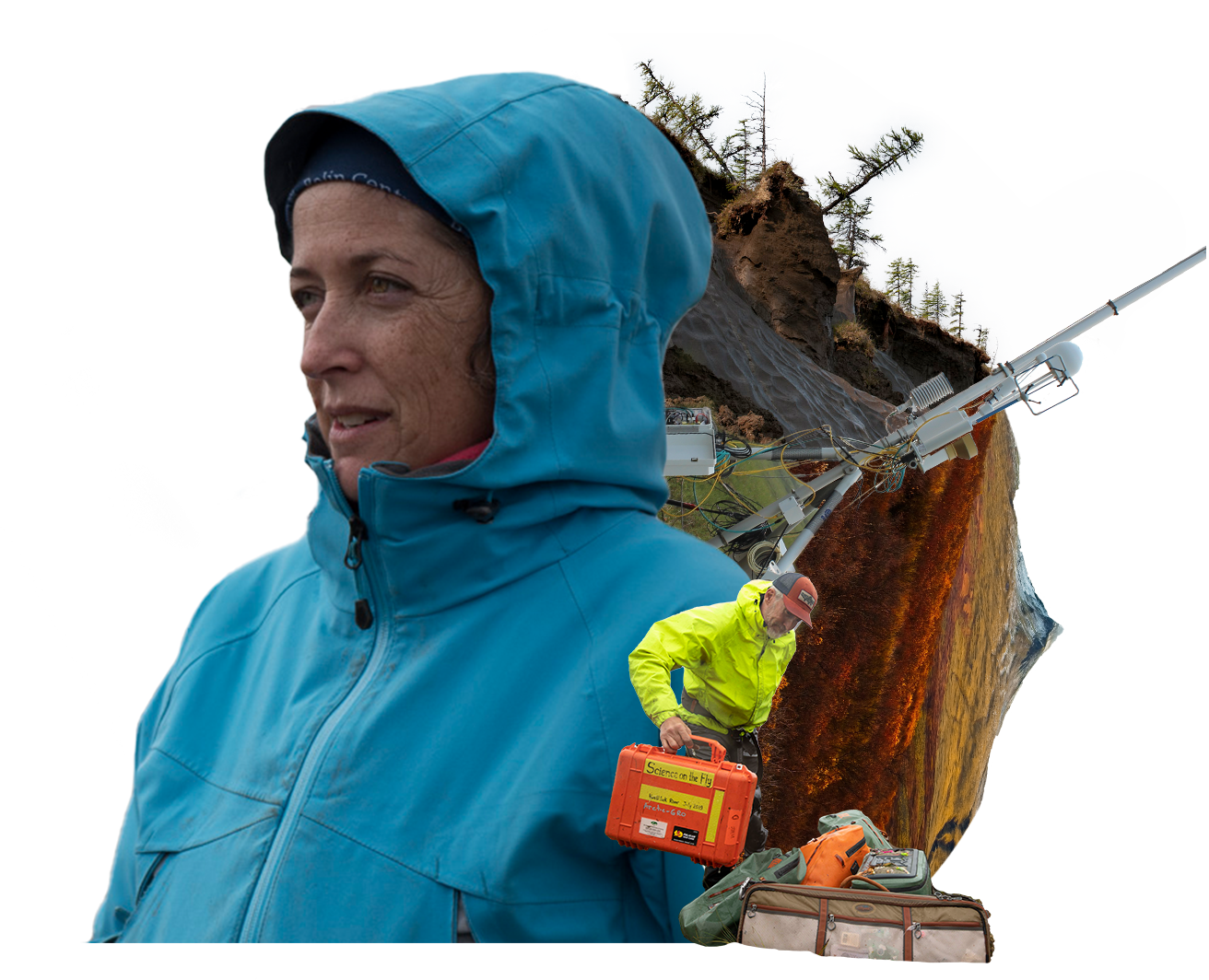
graphic by Nichole Chapman
What’s left to be done
Despite its big strides, Permafrost Pathways is still in its infancy and there is a long road ahead when it comes to tackling the complexity of permafrost thaw. Today, at least 192 countries, plus the European Union, have signed on to the Paris Agreement’s promise of reducing emissions to keep warming below 2 degrees C. But many emissions reduction goals do not include carbon released by permafrost thaw. The international community needs to take strong action to change this or else permafrost thaw could undermine climate goals.
In the Intergovernmental Panel on Climate Change’s 2021 report, permafrost thaw was named as an issue that should be included in carbon budgets and global reduction schedules, but often isn’t because there is not enough data on its climate impact. Continued support of data gathering programs like Permafrost Pathways will provide the international community, top country-level climate negotiators, and environmental ministers the knowledge needed to fix that oversight and start filling gaps.
In Arctic communities, permafrost thaw is already causing disasters like flooding, coastal erosion, and infrastructure damage. To combat this, national and international policy makers need to act now to integrate permafrost thaw into disaster policies and community-led adaptation frameworks. This will create clear planning and response procedures for future permafrost-related issues.
What you can do
Permafrost thaw is an issue that affects everyone. Understanding the local and global implications and sharing that information within immediate social circles as well as on social media platforms can help start conversations that spur action. The public also has the power to influence the development of climate policies by pressuring elected officials to tackle this serious issue.
For more information about the issues surrounding permafrost thaw, read part one and part two in our Permafrost series. To stay informed and get involved, visit the Permafrost Pathways site.




